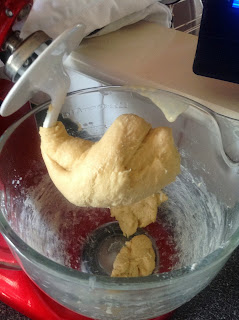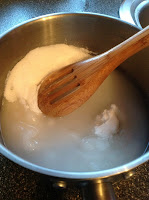Brioche
A classic french bread..rich, slightly sweet with a soft golden crust and yellow buttery crumb..its delicious!
It is widely eaten in France with a milky coffee or hot chocolate for breakfast.
Brioche originated in Normandy over 500 years ago when decadence was the order of the day. During this time, lavish and extravagant french banquets were the norm, and butter was incorporated into foods, including its inclusion into bread.
The word Brioche is derived from the verb "brier" to knead, which is ironic because I hardly kneaded it (thank Kitchenaid for mixers!). It mimics bread, but is technically a pastry because eggs, milk and butter are used in large amounts.
The use of these ingredients produces a very soft, moist dough that is unlike any other I have worked with.
 |
| Very soft dough |
Begin by using the hook attachment on your mixer, if using one. Place flour into the bowl and make a well in the center. Add yeast and half of the milk. Use a little of the flour in the bowl to cover over the wet ingredients. This allows the yeast to begin activation. Once bubbles form, add the sugar, salt and eggs, one at a time, mixing well between each addition. Add the rest of the milk and also mix well.
Mix on low speed, making sure to stop the mixer and scrape the dough off the hook attachment after 5 minutes. Continue mixing until consistency is smooth and elastic.
 |
| This is why you need to scrape the hook! |
Add the butter, a little at a time and mix on medium speed. Turn the dough onto a lightly floured bench and (my favorite part) slap it hard onto the bench. This smacking of dough onto the bench expels any air the yeast may have formed. Do it six times.
Wrap it in plastic and leave it in the fridge overnight.
 |
| Tucking in the dough..goodnight... |
Next, preheat your oven to 200 degrees Celsius. Lightly grease brioche moulds or tins. I used some brioche moulds and muffin tins..the results were asthetically different, but it did not affect the outcome otherwise.
 |
| Using tins and moulds |
Break the dough into ten pieces and roll into shapes. Whilst in France, I found what I called "the snowman" shape was the most popular, so I emulated this shape.
Place the dough into the moulds or tins and allow them to rise, uncovered until doubled in size
 |
| Rolling portions into snowmen |
Once they have risen, brush them in egg wash and bake for 10 minutes. Reduce the oven temperature to 180 degrees Celsius, turn the brioche upside down in their tins and cook for a further few minutes, allowing them to cook through.
 |
| Some Brioche are turned, others are not |
To check if cooked, either use the skewer test or rip the head off one of the snowmen to peek inside.
 |
| Cinnamon and glazed |
 |
| Chocolate drizzled brioche |
Brioche can be made into individual portions,in a braided loaf or into a ring. Personally, prefer the individual sized portions, but it can be used to make a wonderful french toast or in a bread and butter pudding...the possibilities are endless!
 |
| Store bought on the left.... |
Well, there you have it folks...Brioche! The recipe quantities are as follows:
500g plain flour
15g dried yeast
200ml lukewarm milk
1 egg yolk
65g sugar
1 tsp salt
2 eggs
250g unsalted butter, at room temperature
egg wash (1 egg, 1 yolk and 50ml milk beaten together)
















